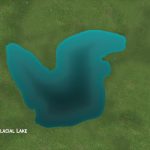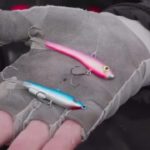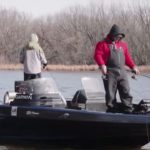Early Morning – Most-Missed Ice Fishing Opportunity
The most universally-missed ice fishing opportunity is the early morning period, a peak feeding time for many species that goes un-drilled on most lakes.
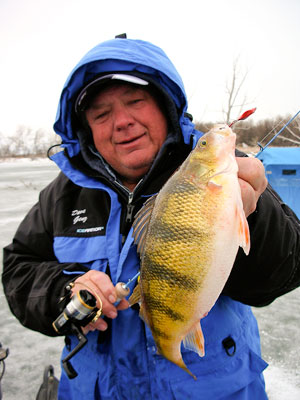 Much more commonly, anglers hit the ice sometime in the afternoon, find a few fish, then do much of their catching as the sun goes down and the fish move around, looking to eat. Often, in those same hot holes from the evening before, good action can be had as the sun is coming back up the next morning.
Much more commonly, anglers hit the ice sometime in the afternoon, find a few fish, then do much of their catching as the sun goes down and the fish move around, looking to eat. Often, in those same hot holes from the evening before, good action can be had as the sun is coming back up the next morning.
“The morning bite doesn’t last as long (as the evening bite),” says Dave Genz, who usually fishes both peak periods as well as the midday hours. “You have to be in position before it starts getting light, because it’s not a time to be out there fumbling around looking for fish.”
Indeed, the last dark minutes right before daybreak is a time to punch strategic holes in known fish-producing areas, then work them intently as the underwater ‘rush hour’ commences.
Genz says that, for best results in early morning, we should think of it as a three-step process that begins the day before.
It goes like this: find some fish the evening before, prepare your gear and make a plan that night, then get out there and execute the plan before the sun rises.
“If we’re going to a lake for the first time early in the morning,” he says, “we just do the best we can. We’ll drill holes in places that should have fish and hope they’re there. Or, we’ll go where the best rumors are. But if we’re going to be in the area for more than one day, we’ll see how the rest of that first day goes. We might hit several lakes, and eventually we should find some fish. Wherever we have the best bite the first evening, we’ll be back there early the next morning.”
That’s how the early morning bite is best played. As best you can, minimize commotion, drill key holes, and let the fish come to you. During the peak periods of dawn and dusk, as Genz has taught us, the whole web of life swings into action. It’s all triggered by ‘vertical migration’ of zooplankton (a fancy term that means tiny animals tend to swim up toward the surface in evening, then back down to the bottom at daybreak). It’s usually best to stay on the move and drill lots of holes at midday, but the peak periods are a time to drill fewer holes and allow fish to seek out your bait.
“Sometimes,” continues Genz, “your biggest fish come in the (early) morning, rather than the evening. The sunset bite usually lasts longer, but by the end of the trip, you count ‘em up and the biggest fish were caught right away in the morning.”
Daybreak at a Civilized Hour
Given that you have to warm up the vehicles, scrape the windows, and load up the gear, that can make early morning ice fishing a challenge. It’s cold and dark out there in the parking lot, so the anticipation of a good catch is what it takes to get many of us fired up.
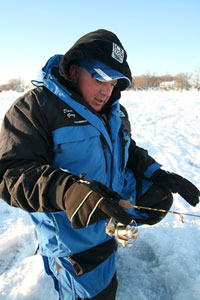 When it comes to answering the bell, though, here’s some good news: early morning doesn’t come as early in the winter as it does in summer. So you can be out there at the crack of dawn after getting a decent night’s sleep.
When it comes to answering the bell, though, here’s some good news: early morning doesn’t come as early in the winter as it does in summer. So you can be out there at the crack of dawn after getting a decent night’s sleep.
“We usually have time for a good breakfast, and to go over the plan,” says Genz, “before it’s time to be out on the ice.”
The Night Before: Get Ready
Whether you’re driving from home to a local lake or on the road fishing distant waters, the key to cashing in at daybreak is preparation the night before. It starts with going over every piece of gear and making sure it’s ready.
“You can’t get out there in the dark and suddenly remember you have to gas up the auger,” says Genz, “or discover that all your rods are tangled up.”
Dave constantly talks about the importance of having a plan. He means everything from gear being ready to knowing where you’re going to drill the first set of holes, to what bait you’re going to put down there first, second, and third.
When he’s on the road, he is a study in organization. His van is set up with storage areas for Fish Traps, Vexilars, Lazer augers, clothing, GPS, rods, lures, and more. At the hotel, gear is brought in and gone over before going out to dinner. Rods are sorted out. Fat Boys, Frostee Jigging Spoons, Darters and Flyers are tied on. Battery chargers are plugged in. Live bait is culled and kept cold, but protected against freezing.
In the morning, it looks like a military operation, as it all goes back into the van as it’s warming up, ready to deploy at the first spot.
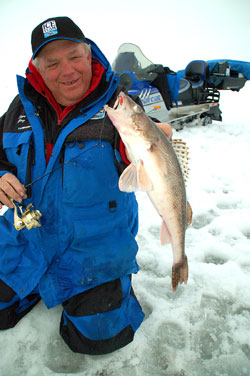 At breakfast, lake maps are spread out and the plan is discussed one more time. By the time the group hits the ice, everybody knows what the plan is, and everybody is quickly jigging in what should be a productive hole.
At breakfast, lake maps are spread out and the plan is discussed one more time. By the time the group hits the ice, everybody knows what the plan is, and everybody is quickly jigging in what should be a productive hole.
That’s the kind of overall preparation it takes to catch nice fish as day is breaking.
“And it all feels worth it when you set the hook,” laughs Genz, “and the battle begins.”
Nothing is ever assured when it comes to fishing, and this is certainly true when it comes to ice fishing. It’s hard to say whether your biggest fish will come in the morning or evening–or even in the middle of the day.
But this much is certain: there’s only one way to find out for sure. And the early morning is the most-missed ice fishing opportunity of all.
Note: Dave Genz, known as Mr. Ice Fishing, was the primary driver of the modern ice fishing revolution. For more fishing tips, go to www.davegenz.com.


